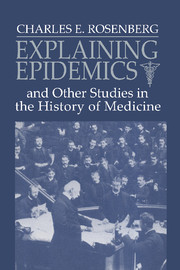Book contents
- Frontmatter
- Contents
- Acknowledgments
- Introduction: Why care about the history of medicine?
- I Ideas as actors
- II Institutions and medical care
- III The past in the present: Using medical history
- 11 The crisis in psychiatric legitimacy: Reflections on psychiatry, medicine, and public policy
- 12 Disease and social order in America: Perceptions and expectations
- 13 What is an epidemic? AIDS in historical perspective
- 14 Explaining epidemics
- 15 Framing disease: Illness, society, and history
- 16 Looking backward, thinking forward: The roots of hospital crisis
- Index
14 - Explaining epidemics
Published online by Cambridge University Press: 29 March 2010
- Frontmatter
- Contents
- Acknowledgments
- Introduction: Why care about the history of medicine?
- I Ideas as actors
- II Institutions and medical care
- III The past in the present: Using medical history
- 11 The crisis in psychiatric legitimacy: Reflections on psychiatry, medicine, and public policy
- 12 Disease and social order in America: Perceptions and expectations
- 13 What is an epidemic? AIDS in historical perspective
- 14 Explaining epidemics
- 15 Framing disease: Illness, society, and history
- 16 Looking backward, thinking forward: The roots of hospital crisis
- Index
Summary
This essay is intended to serve as a companion piece to Chapter 13, which sought to describe an archetypical pattern of response constituting the historical phenomenon we have come to call an epidemic. That chapter generalized about events; this generalizes about modes of explanation. It suggests that there are two fundamental styles of explanation that have been conceptually “available” since classical antiquity – materials with which to construct the reassurances demanded by an epidemic's otherwise apparently random incursions. I have chosen to label these alternative styles contamination and configuration.
There is always a danger in creating such general categories; lumpers versus splitters, hedgehogs versus foxes, vitalists versus mechanists – few individuals fall neatly into one ideal type or the other. Yet such categories remain valuable as analytical tools for the historian; and I argue in the following pages for the analytic relevance of the configuration – contamination alternatives. Although rarely articulated in pure form, these styles of explanation have served in a variety of mixtures and dilutions to provide hypothetical etiologies for successive generations of physicians and laypersons. Modern-day descendants of these styles of explanation remain viable – as we have seen in our past decade's experience with AIDS.
An epidemic is almost by definition frightening; numbers of unfortunates are seized with grave illness, one after another exhibiting similarly alarming and alarmingly similar symptoms.
- Type
- Chapter
- Information
- Explaining Epidemics , pp. 293 - 304Publisher: Cambridge University PressPrint publication year: 1992
- 33
- Cited by



